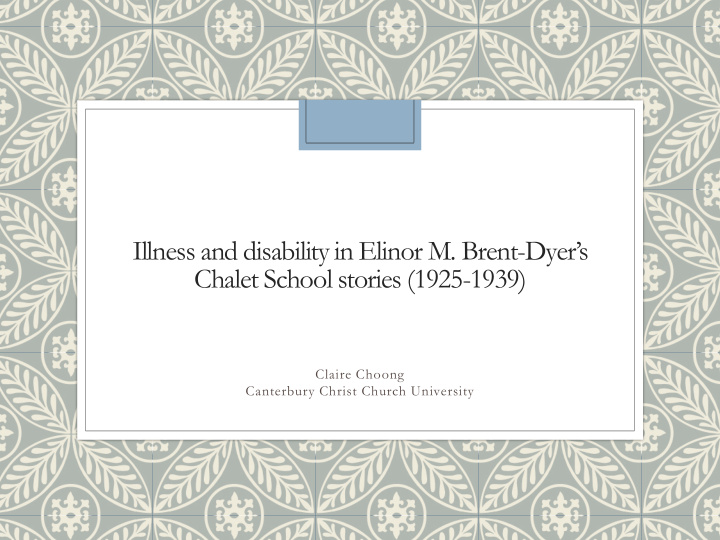



Illness and disability in Elinor M. Brent-Dyer’s Chalet School stories (1925-1939) Claire Choong Canterbury Christ Church University
Introduction ◦ Elinor M. Brent-Dyer ◦ 1925-1970 – 59 books ◦ Set in Austria, Wales and Switzerland (post-WW2) ◦ My reading – 1989-1996, aged 11-18 (?)
From Gladys to Elinor, via Patricia ◦ Born Gladys Eleanor May Dyer, South Shield, 6 th April 1894 ◦ Known at home as May ◦ Eleanor in her teens ◦ Patricia Maraquita at college ◦ Eleanor (Len) ◦ Elinor May (M.) Brent-Dyer
Illness, death and absence ◦ Father (Charles Morris Brent Dyer) abandoned the family when EMBD was 3 ◦ Brother (Henzell Watson Dyer) died of meningitis age 17 in 1912 (EMBD was 18) ◦ Friend (Elizabeth Jobbing) died age 16 “The themes of poor health., death and absence of family […], which are characteristic of the Chalet School series, possibly originated with Brent-Dyer’s early experiences” (Gosling, 1998)
“…an average girl...” “It is certainly probably that […] Brent-Dyer perceived poor health, death and absence of family as having greater significance in the average girl’s family than was in fact the case.” (Gosling, 1998) But I am not an average girl…
Claire ◦ Congenital heart defect (TGA, FVD, PS) ◦ Tracheoesophageal fistula (TOF) ◦ Scoliosis ◦ One kidney ◦ Idiopathic leg pain (short term) ◦ Recurrent chest infections (physio) ◦ Recurrent ear infections ◦ IBS ◦ Glucose intolerance ◦ Depression ◦ Anxiety ◦ ASD?
Examples (Gosling) ◦ Jo(ey) Maynard nee Bettany – susceptible to illness ◦ Grizel knocked out by a stone thrown by Deira ( Head Girl of the Chalet School , 1928) ◦ Maureen’s lack of self-discipline brings down illness on herself and Joey ( Rivals of the Chalet School , 1929) ◦ The Robin – fragile (familial TB) ◦ Mary-Lou Trelawney – head injury ◦ Phoebe Wychcote - “rheumatism”, including weak heart ( Jo to the Rescue , 1945) ◦ Eustacia Benson ( Eustacia Goes to the Chalet School , 1930) – note assimilation before recovery ◦ Et al.
The illness/injury plot device o 18 th -19 th century morality tales (e.g. Sarah Fielding’s The Governess (1749)) o 19 th century fiction (e.g. Marianne in Sense and Sensibility (1811))
Implications of the IIPD ◦ Redemption is possible for (almost) everyone –hoorah! “…it is not ill health, then, that separates a Chalet Girl from her peers, but bad character.” (Gosling, 2009) ◦ Illness as punishment – boo! “What’s it like to be normal?” (Abbott, 1985)
Angels (see also heroes) Angel , by Abbott Handerson Thayer (1887) “The dying tubercular is pictured as made more beautiful and more soulful” (Sontag 1991) “[The Robin was]…almost angelic” (Brent-Dyer, 1940) “I have suffered, and I have survived, but that doesn’t make me a hero […] it just makes me human” (Choong, 2016)
Equality ◦ Girls with ill health are capable of the same intellectual challenges as the rest ◦ Phoebe Wychcote – Jo to the Rescue (1945) – seen and treated as an equal by Jo “I never thought I’d have the luck to meet you!” – Jo Maynard
Why? “perhaps these books were the only place she could actually be in control and save her characters from the harshness of the world outside” (Johnson, 2012) “…you can kill characters. And you can save them. You can make them live and thrive in this world that you, perhaps, can’t” [sic] (Johnson, 2013)
Changes for the Chalet School ◦ Illness/delicacy no longer equated with goodness ◦ Non-disabled girls portrayed as morally superior ◦ Why? • Discovery of penicillin (1928) and its use (1942) • Too many books! - A more realistic picture?
Claire of the Chalet School Unseen childhoods • The Chalet School [stories] as sanctuary •
Conclusion “What a horrible responsibility it is to write for the young!” (EMBD/Jo Maynard, 1936 – Joe Returns to the Chalet School )
Bibliography ◦ Brent-Dyer, E.M. (1925-1969) The Chalet School series ◦ Gosling, J. (2002) 'Changes at the Chalet School: Illness and Disability in the Chalet School Series', in Aveling, H.A. (ed.) Unseen Childhoods: Disabled Characters in 20th-Century Books for Girls London: Bettany Press, pp. 259-301. ◦ Gosling, J. (1998) The Chalet School Series: An Overview. Available at: http://www.ju90.co.uk/css.htm (Accessed: 12th July 2018). ◦ Johnson, L.H. (2013) A 21st Century Chalet School Girl. Available at: https://didyoueverstoptothink.wordpress.com/2013/09/24/a-21st-century-chalet-school-girl/#more- 3805(Accessed: 12th July 2018). ◦ Johnson, L.H. (2012) The Chalet School and Sickness. Available at: https://didyoueverstoptothink.wordpress.com/2012/10/07/the-chalet-school-and- sickness/ (Accessed: 12th July 2018). ◦ Lurie, A. (1998) Don't Tell the Grown Ups: The Subversive Power of Children's Literature. London: Little, Brown and Company. ◦ McClelland, H. (1994) The Chalet School Companion. London: Armada. ◦ McClelland, H. (1988) 'Questions about Elinor', Signal, 56, pp. 123. ◦ Sontag, S. (2002) Illness as Metaphor and AIDS and Its Metaphors. London: Penguin.
Recommend
More recommend